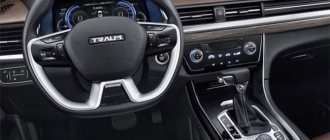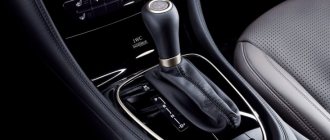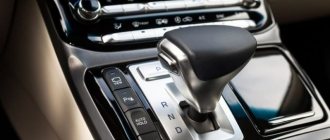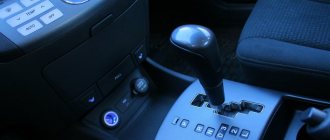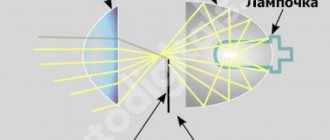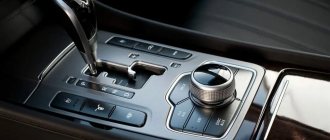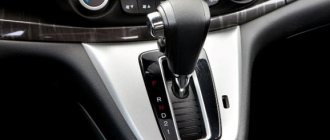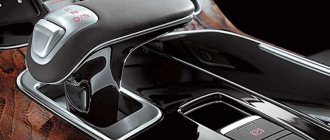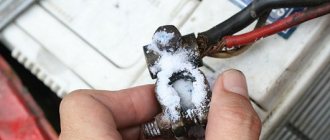Many experienced drivers have forgotten at least once in their lives to remove the handbrake when starting to move the car. This has happened to almost everyone. Most drivers scold themselves for such forgetfulness and inattention, because they know what will happen if they drive with a handbrake. Driving for a long time with the handbrake on can damage your vehicle.
Of course, the handbrake helps in some cases and prevents the car from rolling down a slope. It is especially important to use it in cars with automatic transmissions, because it is not recommended to leave such a car on a slope with the “Parking” mode active. But what happens if an inattentive driver forgot to release the handbrake and drove like that for quite a long time? Let's figure this out.
Will the car go with the handbrake?
Almost any car will move, even if you put the handbrake on it. Of course, it won’t roll down the hill, but the engine effort will be enough to move the car and successfully drive tens of meters, or even kilometers. Of course, this greatly depends on the degree of tightening of the handbrake, engine power, condition of the pads and other factors. And any more or less experienced driver will be able to notice that the car has become tight and does not want to actively gain traction.
So, if a driver has been driving with the handbrake for a long time, there may be consequences. But which ones? More about this.
Recommendations from experienced car owners and mechanics
Question. The owner of the car still did not understand how to properly use the EPB machine.
Answer . There is no need to overload it by putting the parking brake on the car, even while parking near the store. But you don’t need to let it “rust”.
Question. The car owner does not understand what Hill Start Assist, installed on many modern cars with an automatic transmission, is, and why it is needed.
Answer. Hill Start Assist is a parking brake assist system. It automatically applies the vehicle's rear brake pads when the vehicle stops on a mountain or hillside.
Question . How else can you use the electronic handbrake in cars with an automatic transmission?
Answer . The electronic brake system of the automatic transmission can be used as an emergency brake. If you keep the button pressed, the vehicle automatically starts emergency braking. The only negative is that not all cars are equipped with this advantage.
Question. They say that leaving the parking brake on during maintenance can cause injury. Is it so?
Answer . Yes. The EPB must be switched to service mode when a service station employee is working on repairing the machine or any other part of the car. Unintentionally pressing EPB on an automatic machine can not only harm a person, but also break some parts of the vehicle.
Worn pads
The very first and obvious consequence is worn out rear pads. Considering the fact that in most cars the handbrake blocks the rear wheels, the pads wear out there when driving. If the driver does not tighten the lever all the way, or the handbrake itself is weak and does not hold the wheel rims tightly, then the rims may rotate while driving. As a result, there will be strong friction between the pads and discs of the rear wheels of the car, as a result of which both of these elements will wear out.
If you drive with the handbrake, what will happen to the car in this case? If you drive a couple of tens of meters in this position, then nothing bad will happen to the pads. They will heat up, but nothing more. But when driving with a loose handbrake for a long time, the wheels on the car will rotate with strong friction between the discs and pads. The latter will quickly become unusable. As a result, the pads will quickly wear out and will no longer hold the car when the hand brake is activated. That is, the handbrake may simply not hold the car even on a slight slope. Of course, this is unpleasant news, because leaving the car at speed even on an uphill slope is not always appropriate - it can roll down and go downhill even in gear.
So after a long drive with a handbrake, it is advisable to go straight to the car market, buy rear pads for your car, and then go straight to a service station, where experienced technicians will quickly replace the pads. But what happens if you drive with the handbrake for a short time? Absolutely nothing. After a couple of minutes of driving, the pads may wear out a little, but they will still hold the car up or downhill. So there is no need to worry too much about this. However, it is quite possible that due to increased loads the bearings will also become unusable, although the likelihood of this is low. But even they are not very expensive.
If the driver tightens the handbrake all the way when stopping and the pads “grab” the discs as tightly as possible, then when driving with the handbrake active, the wheels may not spin at all. In this case, it will be difficult to even start (most likely, the engine will simply stall), but if you manage to start, the car will drive slowly and accelerate weakly. When accelerating, you can hear the smell of burnt rubber - this means that the rear wheels are rubbing against the asphalt. But even if this does not arouse suspicion in the driver, and he continues to drive, the rubber will be worn until the tires completely burst. The driver will definitely feel this. However, it is quite difficult to wear tires to this condition.
It is extremely rare for this to happen. But if this happens, you will have to change the rear tires. It will be more expensive than the cost of replacement rear pads. However, it all depends on the car and the cost of components.
More information about the electromechanical handbrake
Continuing the topic of the EPB device, we will also touch on the electronic control unit. It includes the control unit itself, input sensors and an actuator. The transmission of input signals to the unit is controlled by at least three control elements - buttons on the central car console, an integrated slope sensor and a clutch pedal sensor located on the clutch drive. The block itself, having received the signal, gives a command to the operating devices, such as the drive motor.
The nature of EPB operation is cyclical, that is, the device turns off and then turns on again. Switching on can be done using the already mentioned buttons on the car console, but switching off is automated - as soon as the vehicle moves, the handbrake will turn off. However, by pressing the brake pedal, you can turn off EPB by pressing the corresponding button. When releasing the brake, the EPB control unit analyzes the following parameters: the position of the clutch pedal, as well as the speed of its release, the position of the gas pedal, and the inclination of the vehicle. By taking these parameters into account, the system can be turned off in a timely manner - the risk of the car rolling away, for example, on a slope becomes zero.
Electromechanical EPB is the most convenient and at the same time effective on cars with an automatic transmission. It performs well when operating a vehicle in large cities, where alternating starts and stops occurs very often. Advanced systems have a special “ Auto Hold ” control button, by pressing which you can temporarily stop without the risk of the car rolling away. This is useful in the already mentioned city - the driver will only need to press this button instead of constantly holding the brake pedal in the down position.
Of course, the advanced electromechanical parking brake seems futuristic and extremely convenient. In fact, there are at least 3 shortcomings that negatively affect the popularity of EPB. But let’s also touch on the advantages of the system:
- Advantages : compactness, extreme ease of operation, no need for adjustment, automatic shutdown at start, solution to the problem of car rollback;
- Disadvantages : high cost, dependence on the battery charge (if it is completely discharged, you will not be able to remove the car from the handbrake), inability to adjust the braking force.
The main disadvantage of EPB only occurs under certain conditions. If the car is idle for a long time, the battery will have time to discharge - there is no secret in this. For owners of a working city car, this problem is rare, but if the vehicle really needs to be left in the parking lot for some time, you will either have to get a charger or keep the battery charged. As for reliability, practice has shown that EPB is inferior to more familiar handbrake systems in this parameter, but only slightly.
Engine
When talking about what will happen to the car if you drive with the handbrake, we must not forget about such an important element of the system as the engine. The power plant will take on heavy loads when starting off with the wheels locked. The car will shake and the engine will need a lot more power to move. Often, when the handbrake is on, drivers cannot move at all due to the fact that the engine simply cannot pull the load and choke. These are quite serious tests for the motor, so it is better not to allow this to happen. Of course, it is unlikely that the motor will be damaged in this way, but it will definitely be subjected to heavy loads.
Do not use in cold weather or when frost is likely.
When winter sets in, it is highly discouraged to use the handbrake, especially during sudden changes in temperature outside.
Using the mechanism during frost increases the possibility of brake pads freezing to the drums or disc. The result is completely jammed wheels. Then you will have to wait until everything thaws to avoid the mechanism breaking down.
If this happens, you can try using hot water, but this method does not work for everyone. Therefore, it is better not to take risks.
What to do if the pads are frozen Car owners know firsthand about the problem of pads freezing. The reasons for this unpleasant situation...
Will the car go with the handbrake?
Almost any car will move, even if you put the handbrake on it. Of course, it won’t roll down the hill, but the engine effort will be enough to move the car and successfully drive tens of meters, or even kilometers. Of course, this greatly depends on the degree of tightening of the handbrake, engine power, condition of the pads and other factors. And any more or less experienced driver will be able to notice that the car has become tight and does not want to actively gain traction.
So, if a driver has been driving with the handbrake for a long time, there may be consequences. But which ones? More about this.
Types of parking brake
According to the type of drive, the handbrake is divided into:
- mechanical;
- hydraulic;
- electromechanical parking brake (EPB).
Cable drive of the parking brake
The first option is the most common due to its simplicity of design and reliability. To activate the handbrake, simply pull the handle towards you. Tight cables will lock the wheels and reduce speed. The car will brake. The hydraulic handbrake is used much less frequently.
Worn pads
The very first and obvious consequence is worn out rear pads. Considering the fact that in most cars the handbrake blocks the rear wheels, the pads wear out there when driving. If the driver does not tighten the lever all the way, or the handbrake itself is weak and does not hold the wheel rims tightly, then the rims may rotate while driving. As a result, there will be strong friction between the pads and discs of the rear wheels of the car, as a result of which both of these elements will wear out.
If you drive with the handbrake, what will happen to the car in this case? If you drive a couple of tens of meters in this position, then nothing bad will happen to the pads. They will heat up, but nothing more. But when driving with a loose handbrake for a long time, the wheels on the car will rotate with strong friction between the discs and pads. The latter will quickly become unusable. As a result, the pads will quickly wear out and will no longer hold the car when the hand brake is activated. That is, the handbrake may simply not hold the car even on a slight slope. Of course, this is unpleasant news, because leaving the car at speed even on an uphill slope is not always appropriate - it can roll down and go downhill even in gear.
So after a long drive with a handbrake, it is advisable to go straight to the car market, buy rear pads for your car, and then go straight to a service station, where experienced technicians will quickly replace the pads. But what happens if you drive with the handbrake for a short time? Absolutely nothing. After a couple of minutes of driving, the pads may wear out a little, but they will still hold the car up or downhill. So there is no need to worry too much about this. However, it is quite possible that due to increased loads the bearings will also become unusable, although the likelihood of this is low. But even they are not very expensive.
Purpose of the parking brake device
The parking brake (also called the handbrake or, in short, just the handbrake) is an important element of the braking control of your car. The main system is used directly while driving. But the parking brake works differently: it will hold the car in place if it is parked on a surface that has a slope. It helps make sharp turns in sports cars. Using the handbrake can also be forced: if the main brake system fails, you will use the handbrake to stop the car in an emergency, emergency manner.
This is interesting: How many cubes in gas 53
Engine
When talking about what will happen to the car if you drive with the handbrake, we must not forget about such an important element of the system as the engine. The power plant will take on heavy loads when starting off with the wheels locked. The car will shake and the engine will need a lot more power to move. Often, when the handbrake is on, drivers cannot move at all due to the fact that the engine simply cannot pull the load and choke. These are quite serious tests for the motor, so it is better not to allow this to happen. Of course, it is unlikely that the motor will be damaged in this way, but it will definitely be subjected to heavy loads.
Other elements of the vehicle system are also affected, including suspension, transmission, etc.
Why do you need a handbrake in a car with automatic transmission: explanations from a car mechanic
No matter how many times I drove a car with an automatic transmission, I never used the handbrake. And one day fate brought me to a car service center, where everything was essentially explained to me. I am sure that there will be those readers who, as they say, are not in the know.
I have always followed this logic: the car has a “Parking” mode. If you move the automatic transmission lever to this position, then nothing will ever happen to the car. Therefore, I decided that with an automatic transmission the handbrake is not needed at all. I didn't even check it when I bought the car. But it was not new.
The box was then diagnosed well for me. I was convinced of its “almost perfection”. And the handbrake... It turned out that it doesn't work at all. But I repeat, I didn’t know about this because I didn’t use this thing.
The mechanic at the car service center said that if I continue to ignore the handbrake, I will soon come to them again to repair the automatic transmission.
This, as you might guess, is the worst dream of any owner of a car with an automatic transmission. Because automatic transmission, even on a Granta, is not cheap. And they also charge a couple of tens of thousands of rubles for repairs - at least.
Let's get to the point: let's figure out why it is better to put a car with an automatic transmission in the handbrake, and not just in "Parking":
- If the parking brake is activated, the load goes to the pads. That's how it's supposed to be. This is what the designers intended. It’s not for nothing that factories continue to equip cars with handbrake controls.
- If the car is held in place only due to the fact that the gearshift lever is moved to the “Parking” position, then the car is held by one small latch (lock) in the automatic gearbox. And this part can quickly fail under load. The teeth will break off - that’s all.
Automatic transmission - how to use
First of all, you need to understand how modes are switched in an automatic transmission
Automatic transmission switching and control modes
The automatic transmission is controlled as follows. • Parking (letter P on the selector) – designed to start the engine. Switching to position P is made after a complete stop and putting the car on the “handbrake”;
• Forward movement (D) – standard automatic transmission operating mode, used more often than others;
• Reverse (reverse, position R) – the car can only move backwards. Shifting while stopping with the brake pedal pressed;
• “Neutral” (N) – mode when the engine and automatic transmission are completely open. Most often used to warm up the engine at idle in cold weather;
• D3 (S) - Low gear modes: switches on descents or ascents. The car is braked more by the engine;
• D2 – designed for difficult conditions (slippery surfaces, mountain roads, etc.). Driving is possible in first and second gear. Driving in third and fourth gear is prohibited.
• D1 on Japanese cars is designated as L - movement is only possible in first gear. It is mainly used when engine braking on steep descents, driving on a dirty, swampy or icy road, where you need to move “pull”, without changing the throttle.
Additional automatic transmission operating modes
In addition, more modern automatic transmissions are equipped with an increasing number of additional operating algorithms: normal or normal (N), economical (E), sport mode (S) and others. There is an overdrive mode, this mode is discussed in a separate article.
Basic rules for using an automatic transmission
First of all, you should remember that automatic transmissions do not like sharp accelerations and prolonged wheel slipping - this leads to overheating of the automatic transmission. If it is impossible to move in any direction, you should not frantically move the rocker in the selector groove, but rather seek outside help and push or tow the car. The general process of driving a car and using an automatic transmission is as follows. To start using the automatic transmission you need:
- press the brake pedal, the selector switches from position P, N or R to position D;
- the car is released from the handbrake;
- after smoothly releasing the brake pedal, the car will gradually and smoothly begin to move forward;
- to increase speed, you should use the accelerator more, which will be accompanied by increasing gears; — to reduce speed, just release the pressure or completely release the gas pedal. Gears will shift downward;
- if you want to slow down or stop more significantly, you must apply the brake, and when you resume movement, you just need to use the gas pedal again;
- It is important to remember that with such a driving rhythm, the gearbox must always be in “drive” (position D), which is advisable to change only during long periods of parking.
Additional algorithms for automatic transmission operation
Winter mode “automatic” Depending on the manufacturer, it may have different markings: Winter , icon * , Snow , W , etc. The main purpose of the winter mode is to minimize slippage, which eliminates the activation of first gear. The second stage is used for starting, which allows torque to be transferred more smoothly to the wheels, which is very important on slippery surfaces. Any gear change takes place at lower engine speeds, thereby ensuring smooth operation of the gearbox and almost completely eliminating the possibility of skidding. When the ambient temperature is warm, activating this algorithm is strictly prohibited.
It is strictly forbidden to move the gear shift lever to the “P” or “R” position. To move the lever to this position you need to stop. Otherwise, you can damage the automatic transmission. It is also not recommended to move the lever to the “N” position while driving; this can cause a skid, especially on an icy road. The gear shift lever can be moved to all other positions while driving. It is also recommended to move the lever to the “N” position during long stops with the engine running, for example, in traffic jams or traffic lights. This is especially true in summer, at high temperatures, as it will help to avoid overheating of the machine.
